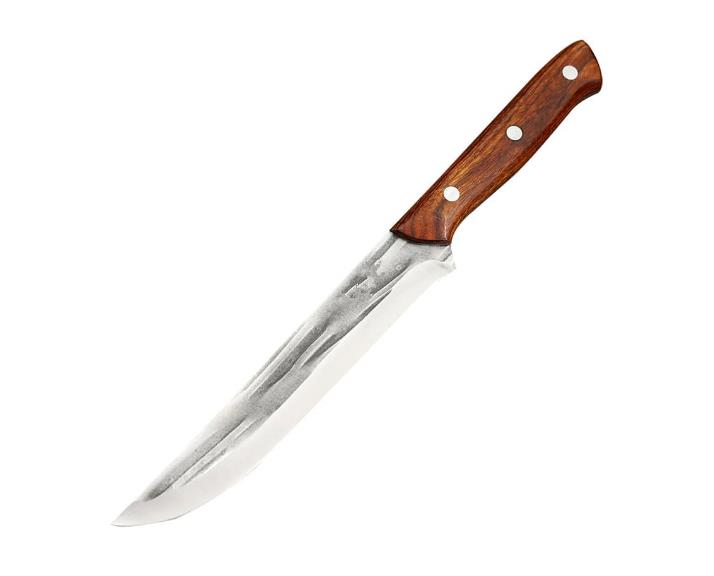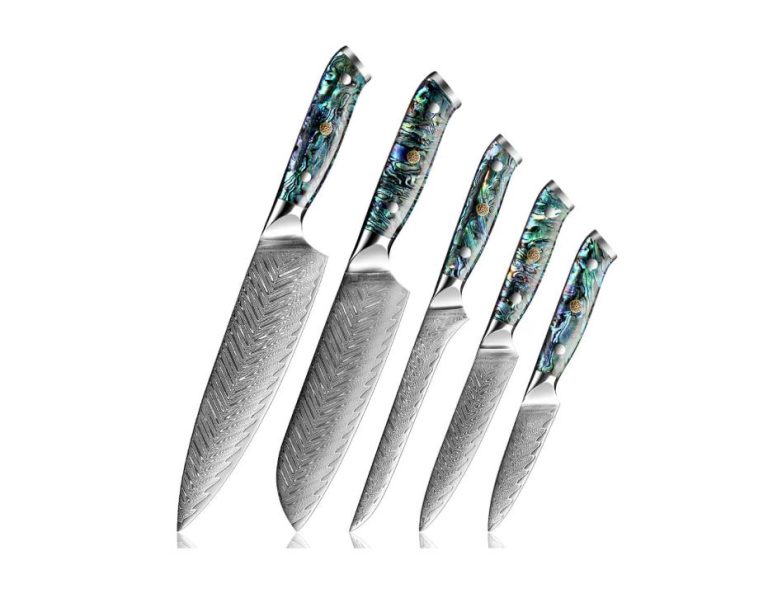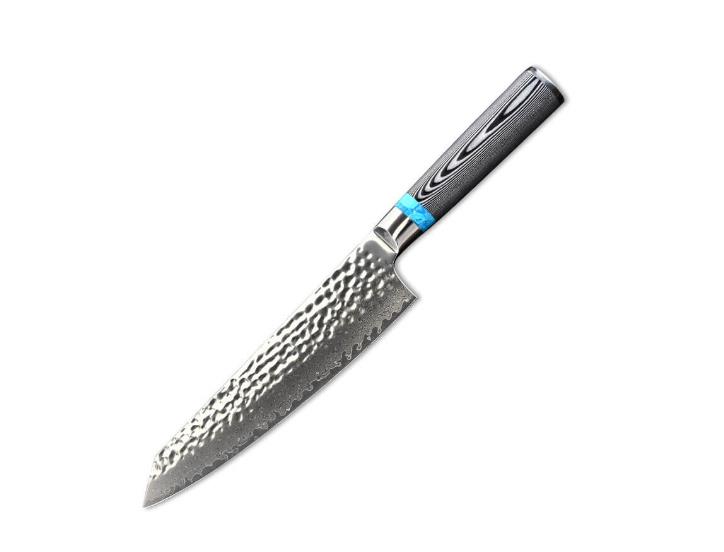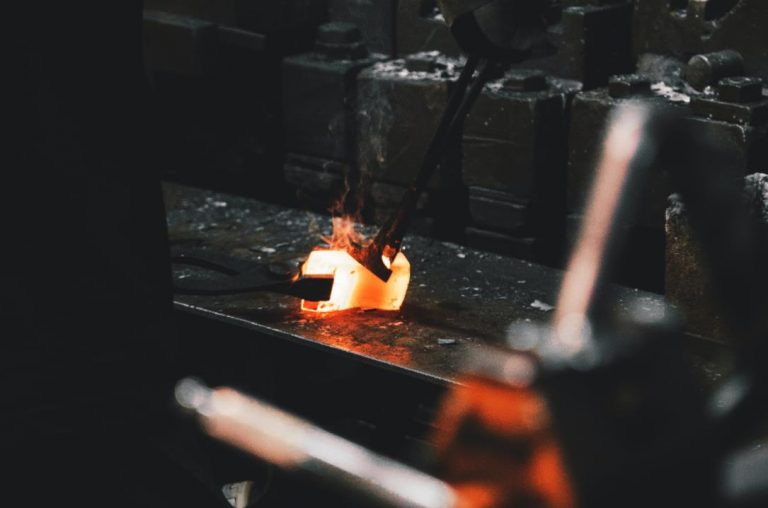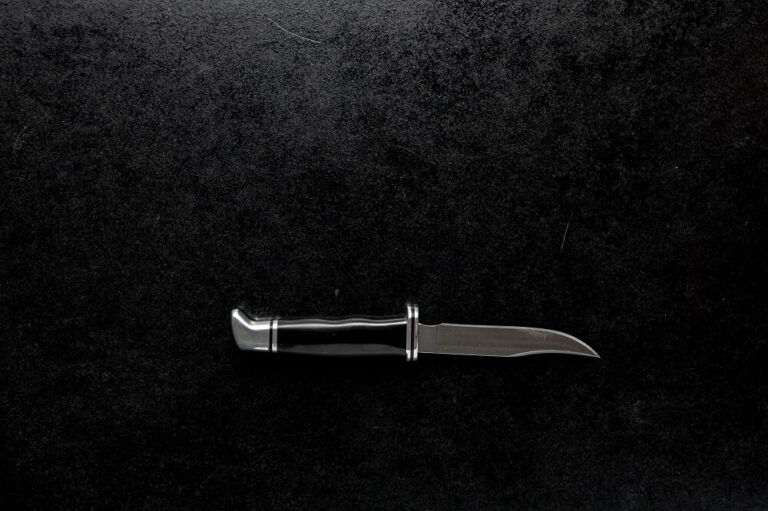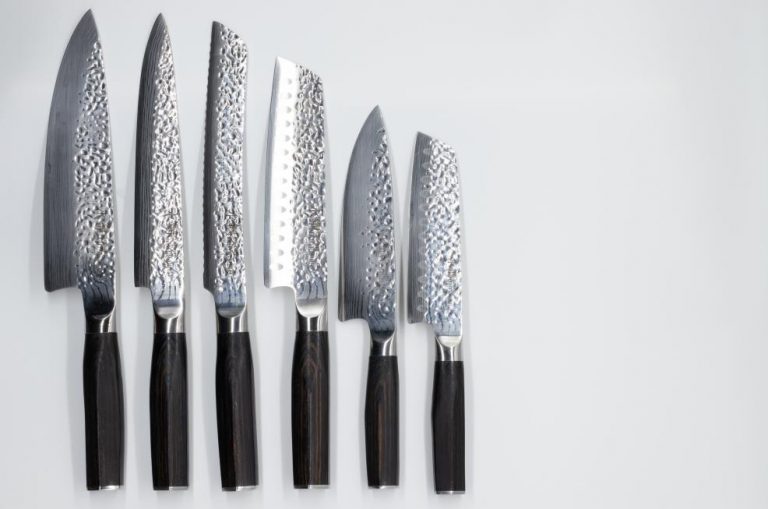Knife retailers should understand the importance of a well-formed knife handle and the many different materials that a knife handle could be made of.
An effective knife handle is vital to the overall operation and handling of any knife. In this article we’re looking at different handle materials and suggesting some industry favorites.
Which handle materials are going to offer your customer the best kitchen experience? What options are available out there? What factors should you be considering when it comes to sourcing superior knife handles?
We’re going to address all these questions and more in our look at knife handle materials!
What makes a good knife handle material?
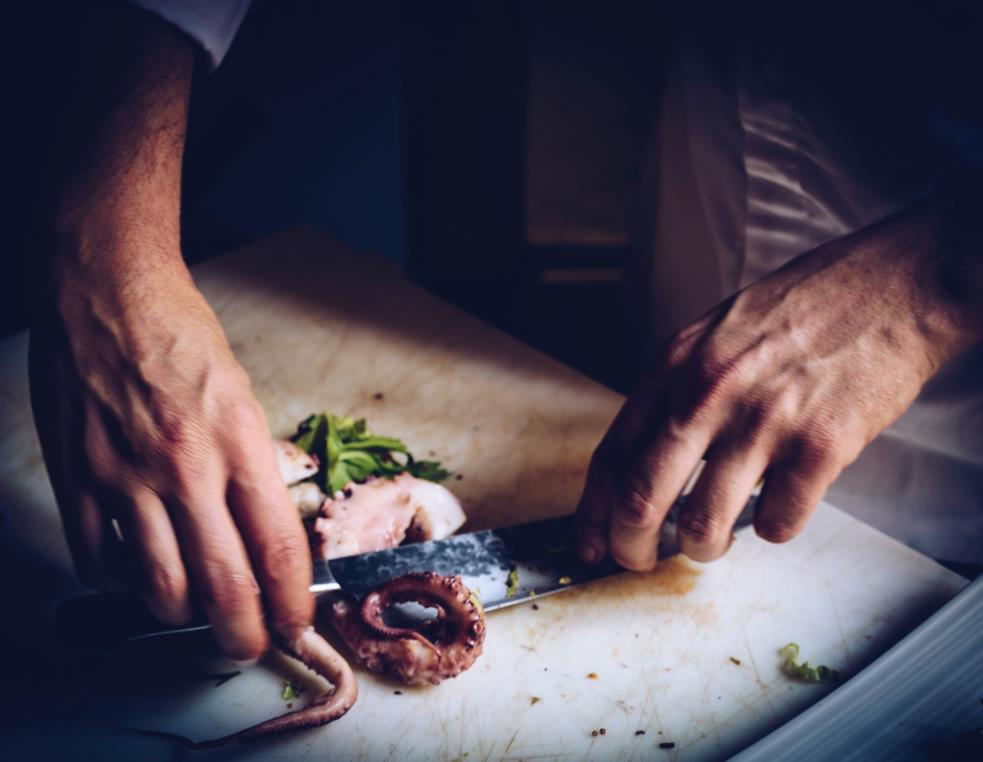
The right knife handle can transform an unwieldly, unattractive, and unsafe kitchen knife into an object of beauty, performing like a master and giving its user pleasure to hold.
Let’s look at some things that need to be considered when choosing a knife handle:
- Aesthetic – pleasing to the eye
- Balance – balanced to suit the buyer & cutting stroke
- Durability – will last over time
- Grip – the grip is comfortable, formed to hold easily
- Safety – safe to use without injury or strain
- Corrosion/Moisture resistance – it should repel liquids
If you’re ticking these boxes, you can be confident that the buyer will receive a knife product that will give them decades of pleasurable use!
In terms of knife handle materials, what options are out there for the knife seller? Let’s first look at some natural handle materials.
Want to learn about designs? Explore our article: Knife Handle Designs: Materials, Geometry, and More
Natural knife handle materials
Natural materials offer an earthy and sympathetic gripping surface, so it’s no wonder that they see regular use for knife handles.
Pakkawood
Pakkawood is a stabilized wood, layers of hardwood veneers infused with resin under high pressure. It combines the visual appeal of wood with the enhanced durability of synthetics, making it a smart mid-range material for knife makers and sellers.
It’s highly water-resistant, dense, and resists cracking or warping better than untreated hardwoods. With its smooth surface and variety of wood grain finishes, pakkawood balances form and function well.
Price & Use Case:
- Moderate price point
- Suitable for mid-tier kitchen knives, gift sets, or outdoor blades that require water resistance
- A great option for customers who like the look of natural wood but want lower maintenance
Sourcing Tip:
Pakkawood is often marketed under different names (like Staminawood or Dymondwood), so clarity in product specs matters when selecting a supplier.
Bone
Bone has been used in knife handles for centuries, prized for its natural look, smooth polish, and traditional appeal. Typically made from cow bone, it’s often dyed, carved, or jigged (textured) to create a variety of finishes.
Bone handles are lightweight and easy to shape, but they’re also porous, meaning they can absorb moisture over time if not properly sealed.
As a result, they’re best suited for display pieces, collector knives, or light-use pocket knives rather than high-moisture kitchen environments.
Price & Use Case:
- Generally low to moderate cost
- Best for hunting knives, collector blades, or heritage-inspired designs
- Appeals to customers looking for a vintage or handcrafted aesthetic
Selling Tip:
Look for stabilized or resin-filled bone handles if durability is a concern. Note that some customers may ask about ethical sourcing, another reason to clarify materials in your product descriptions.
Mother of Pearl
Mother of Pearl is a luxurious handle material made from the iridescent inner layer of mollusk shells, most commonly oysters or abalones. Known for its shimmering, opalescent surface, it adds instant elegance to any knife.
It’s not just decorative. Mother of Pearl is smooth to the touch, naturally moisture-resistant, and surprisingly durable for its delicate appearance. That said, it’s not meant for rough use, this material is more about presentation than performance.
Price & Use Case:
- High-end material
- Common in collector’s knives, ceremonial blades, and gift sets
- Appeals to luxury buyers, collectors, or anyone seeking a refined, premium finish
Selling Tip:
Mother of Pearl handles are often paired with fine inlays or engraving — making them ideal for limited-edition SKUs. Be sure to emphasize craftsmanship in your product listing.
Ebony wood
Ebony wood is known for its deep, rich black tones – often described as gothic or jet-black, that give any knife an unmistakably premium look.
Its dense structure and smooth, fine grain allow for a high-gloss polish that resists wear and adds instant visual appeal.
Functionally, ebony is more than just handsome. It’s naturally moisture-resistant and has mild antibacterial properties, making it a smart choice for kitchen knives and chef-grade tools.
Ebony handles are heavy and solid, ideal for users who prefer a knife with weight and balance. That tactile density not only feels substantial but also enhances control during cutting tasks.
Price & Use Case:
- High-end price point
- Common in premium kitchen knives, high-performance chef knives, and collector blades
- Ideal for customers seeking both aesthetics and durability
Selling Tip:
Look for sustainably sourced ebony or alternatives like “African blackwood” when targeting eco-conscious buyers. Pairing ebony with brass or mosaic pins elevates the visual appeal further.
Rosewood
Rosewood, especially Indian Rosewood, is a popular choice for knife handles thanks to its balanced qualities and accessible price point. It offers a smooth, comfortable grip and develops a rich, attractive patina over time, something many users appreciate in a well-used knife.
This dense hardwood is naturally oily, which helps it resist moisture and repel pests like wood borers. The oils also give it a subtle, pleasant fragrance and a polished finish without the need for synthetic coatings.
Rosewood is strong without being overly heavy, making it ideal for knives that need control without fatigue. Visually, it ranges from warm reddish tones to dark chocolate hues, giving sellers a range of aesthetic options to offer.
Price & Use Case:
- Mid-range price
- Ideal for kitchen knives, utility knives, and gift-ready sets
- Great for buyers who want traditional looks with dependable performance
Selling Tip:
Rosewood can be sustainably sourced and is often viewed as an eco-friendlier alternative to more exotic hardwoods. Be mindful of CITES regulations if exporting internationally.
Teak wood
Teak is a well-regarded natural material for knife handles, especially for customers who value a warm, organic look and feel. While it may not have the dramatic sheen of ebony or rosewood, teak takes oil treatments beautifully, developing a deeper tone and subtle shine over time.
Long used in boatbuilding, teak is naturally resistant to moisture, rot, and pests, making it well-suited for humid environments or kitchen use. Its slightly textured grain provides a secure grip, especially useful when handling slippery tasks like deboning or skinning.
However, compared to denser hardwoods, teak is somewhat softer and may show wear over time. It’s best suited for knives that see moderate use, or for customers who don’t mind maintaining their tools.
Price & Use Case:
- Mid-range pricing
- Great for kitchen knives, outdoor blades, and rustic or utility-style designs
- Appeals to users who prefer natural, tactile finishes over high-gloss looks
Sourcing Tip:
Responsibly sourced teak is widely available, but oil-finished versions offer better longevity and customer satisfaction. Mention this care detail in your product listing or packaging.
Stabilized wood
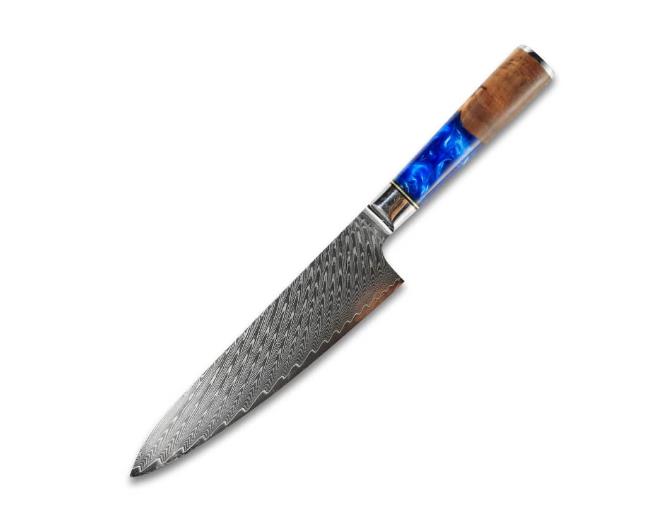
Stabilized wood combines the charm of natural grain with the resilience of high-performance materials, making it a favorite among knife buyers who want the best of both worlds.
Through a vacuum process, natural wood is infused with resin. The result? A handle material that resists water, bacteria, and warping, all while preserving the organic texture and look of real wood.
This process doesn’t just harden the wood. It also:
- Improves impact resistance
- Adds weight, giving the handle a solid, confident feel
- Increases longevity by resisting UV damage and color fading
- Keeps it stable in hot or fluctuating climates, minimizing cracking or shrinkage
For sellers, stabilized wood is a versatile material that can be custom-dyed or patterned, perfect for product lines that want visual appeal without sacrificing function.
Price & Use Case:
- Mid-to-high price point
- Ideal for both kitchen and outdoor knives
- Great for customers who want a wood handle with less maintenance
Selling Tip
Highlight the “low maintenance” angle in your listings, stabilized wood is perfect for customers who want wood aesthetics but not the upkeep.
Abalone shell
Abalone shell brings natural brilliance to knife handles with its rainbow shimmer and ocean-inspired aesthetic.
Though typically used as an accent or inlay rather than for full-handle construction, it adds a touch of luxury and uniqueness to high-end designs.
Abalone is naturally hard and moisture-resistant, and is often sealed for extra durability. It polishes to a smooth, glass-like finish and makes any knife stand out, visually and in hand-feel.
Price & Use Case:
- Higher price tier
- Ideal for boutique, custom, or display-grade knives
- Appeals to collectors or gift shoppers looking for something striking
Selling Tip:
No two pieces of abalone look the same, a perfect selling point for customers who value exclusivity and detail. Highlight it as a visual upgrade that elevates the entire product line.
Synthetic knife handle materials
Man made knife handle materials have come a long way in recent decades and our examples will demonstrate that.
With the industry knowledge and manufacturing ‘know how’ to develop impressive materials, knife manufacturers have really stepped up to the plate with materials that are good for knives, and good for knife users.
Let’s have a look at some of today’s top picks in synthetic knife handles!
Micarta
Micarta is a synthetic handle material made by layering fabrics like linen, canvas, or paper in resin and compressing them under high pressure.
The result is a dense, durable material with a handcrafted look and a slightly textured feel.
Thanks to its strength and moisture resistance, Micarta performs exceptionally well in both kitchen and outdoor knives. It maintains a secure grip even when wet and doesn’t crack or warp with temperature changes, making it a reliable, low-maintenance choice.
The fabric layers used in Micarta create natural-looking patterns and subtle variations, giving each handle a distinct visual character.
That balance between toughness and aesthetics makes it a favorite for practical users who still care about design.
Price & Use Case:
- Mid-range pricing
- Excellent for kitchen knives, bushcraft knives, and EDC-style blades
- Appeals to buyers who want performance without sacrificing visual appeal
Selling Tip:
Market Micarta as a “no-nonsense performer” tough enough for daily use, stylish enough for modern knife designs. Highlight the material’s textured grip as a feature for cooks or outdoor users who prioritize control.
G10
G10 is a high-pressure fiberglass laminate, made by layering glass cloth in epoxy resin, then compressing it to form a tough, lightweight, and highly durable material. Once cured, it’s non-toxic and safe for food contact, making it a practical option for kitchen use.
Known for its exceptional strength-to-weight ratio, G10 performs well in both professional kitchen settings and rugged outdoor conditions. Its naturally grippy texture, even when wet, makes it especially popular in tactical and utility knives.
It’s also a favorite for its design flexibility, G10 can be machined into ergonomic shapes and comes in various colors and patterns.
Price & Use Case:
- Affordable mid-range material
- Excellent for kitchen knives, outdoor knives, and EDC tools
- Appeals to buyers who want durability, grip, and low maintenance without the cost of premium synthetics
Selling Tip:
Market G10 as a “workhorse material” durable, versatile, and cost-effective. Highlight its textured grip and water resistance when targeting chefs, home cooks, or outdoor gear customers.
Pakkawood
Pakkawood is a stabilized wood composite made by layering hardwood veneers with plastic resins under high pressure. The result is a material that combines the warm, natural look of wood with the moisture resistance and durability of synthetic materials.
It’s water-impermeable, non-porous, and resistant to warping or bacterial growth, making it a solid choice for kitchen knives where hygiene is key. Its smooth but shapeable surface can be textured for better grip, offering both comfort and control.
Visually, pakkawood retains the beauty of natural grain, but with unique coloration and finishes, no two handles look exactly alike.
Price & Use Case:
- Affordable to mid-range
- Ideal for home kitchen knives, entry-level chef tools, and aesthetic-forward gift sets
- Great for customers who want the warmth of wood without high upkeep
Selling Tip:
Pitch pakkawood as a low-maintenance upgrade to natural wood — it’s especially appealing to first-time knife buyers or customers who want “natural looks, modern performance.”
Carbon fiber
Carbon fiber is a high-tech material made from strands of carbon woven together and set in epoxy resin.
Known for its exceptional strength-to-weight ratio, it offers top-tier performance in a sleek, ultra-light package.
While it’s more expensive than other handle materials, due to its complex production process, it’s a strong fit for premium product lines or performance-focused customers.
Carbon fiber is highly resistant to corrosion, moisture, and temperature fluctuations. It can also be sandblasted for extra grip, making it ideal for both kitchen and field use where slippage is a concern.
That said, while it’s extremely strong, it can chip on sharp impact, so it’s better suited to careful users or knives intended for precision work.
Price & Use Case:
- Higher-end pricing
- Best for high-performance chef knives, tactical knives, or collector-grade tools
- Appeals to users who want cutting-edge materials and minimalist weight
Selling Tip:
Position carbon fiber as a premium upgrade for buyers who value innovation, durability, and sleek design. Highlight its utility in both modern kitchens and outdoor environments.
Other synthetics: FRN, polymer, plastic
Not all synthetic knife handles fall into the premium category. Some are designed for cost efficiency and large-scale production, making them ideal for entry-level or mass-market knife lines.
Let’s break down three common options:
FRN (Fiberglass Reinforced Nylon)
FRN is a durable plastic reinforced with glass fibers, offering great impact resistance at a low cost. It’s lightweight, resistant to moisture, and nearly maintenance-free — though not as refined in feel as G10 or Micarta.
Best for: budget-friendly utility knives, outdoor gear, or starter kitchen knives
Polymer
“Polymer” is a general term that covers a wide range of molded plastics. In knife handles, it’s used for its flexibility and low production cost. Some polymers are textured or rubberized for grip, while others focus on weight reduction.
Best for: lightweight knives or mass-produced models where price is a key factor
Basic Plastic
Standard injection-molded plastic is the most cost-effective option, but also the least durable. It’s used in disposable or ultra-budget knives and should be clearly labeled as such when positioning your product line.
Best for: one-time-use items, giveaways, or ultra-low-cost private label ranges
Grivory
Grivory is a high-performance thermoplastic made from a nylon-based polymer reinforced with glass fibers. It offers excellent rigidity, dimensional stability, and heat resistance, making it a step up from standard plastics in terms of structure and strength.
Best for: mid-range knives that need added stiffness and heat resistance without jumping to premium materials like G10
Lexan
Lexan is a brand of polycarbonate known for its outstanding impact resistance and optical clarity. While more common in safety equipment, it’s occasionally used in knife handles for its toughness and shatter resistance.
Best for: knives intended for high-impact environments or brands looking to experiment with transparent or ultra-rugged handle designs.
Metal knife handle materials

Metal handles bring a sleek, modern look with excellent durability. While they’re heavier than wood or synthetics, many customers prefer the solid, cold-in-hand feel, especially for contemporary kitchens or professional-grade tools.
Stainless Steel
Stainless steel is one of the most common metal handle materials, especially in fully forged kitchen knives. It’s highly resistant to corrosion, easy to sanitize, and offers a long-lasting, polished appearance, ideal for chefs and home cooks who value hygiene and simplicity.
Because of its weight and density, stainless handles provide a solid, balanced feel in the hand, especially when paired with a full-tang blade.
However, the surface can feel slippery when wet, which is why many designs incorporate finger grooves, dimples, or matte finishes for improved grip.
While it lacks the warmth of natural materials, stainless steel shines in modern or minimalist knife designs where performance, longevity, and a sleek look matter most.
Price & Use Case:
- Mid-range pricing
- Common in forged kitchen knives and commercial-use tools
- Great for customers prioritizing durability and low maintenance
Selling Tip:
Position stainless steel as a professional-grade option, especially when paired with full-tang blades for a seamless, modern aesthetic.
Aluminum
Knives with Aluminum handles are known for their lightweight feel, making them easy to maneuver and ideal for users who prefer a knife with less heft.
While aluminum isn’t as hard as stainless steel, it holds up well in daily use, especially when anodized for added scratch resistance and strength.
This material is popular in both kitchen and outdoor knives because it provides a balanced mix of comfort and durability. It also allows for vibrant color options, making it a favorite in knives aimed at design-conscious or younger buyers.
Aluminum has a slightly softer feel compared to stainless or titanium but can be shaped easily into ergonomic designs for better control.
Its natural resistance to corrosion makes it low-maintenance, though it may show signs of wear faster than harder metals.
Price & Use Case:
- Affordable to mid-range
- Great for everyday carry knives or casual kitchen tools
- Appeals to users who want less wrist fatigue and more color customization
Selling Tip:
Highlight aluminum for customers who want lightweight control and low effort, especially useful for cooks with limited grip strength or mobility.
Titanium
Titanium is a top-tier material that combines exceptional strength, featherlight weight, and a clean, modern aesthetic.
Though more expensive to source and machine, it offers superior performance in harsh environments, making it ideal for chefs, collectors, or professional users who demand long-term reliability.
Titanium handles are naturally corrosion-resistant and non-reactive, meaning they won’t rust, pit, or chemically interact with food or moisture.
They’re often favored in minimalist, high-end knives due to their subtle matte finish and distinctive hand-feel.
Unlike stainless steel, titanium stays warm in the hand and absorbs less shock, improving comfort during extended use.
It’s also hypoallergenic and non-magnetic, making it suitable for users with sensitivities or specialized workplace needs.
Price & Use Case:
- High-end pricing
- Best for collector-grade or minimalist chef knives
- Appeals to buyers who want long-lasting performance with modern appeal
Selling Tip:
Market titanium handles as an investment, they’re not just durable, they elevate the product’s value and speak directly to premium customers.
Knife handles – how to choose wisely
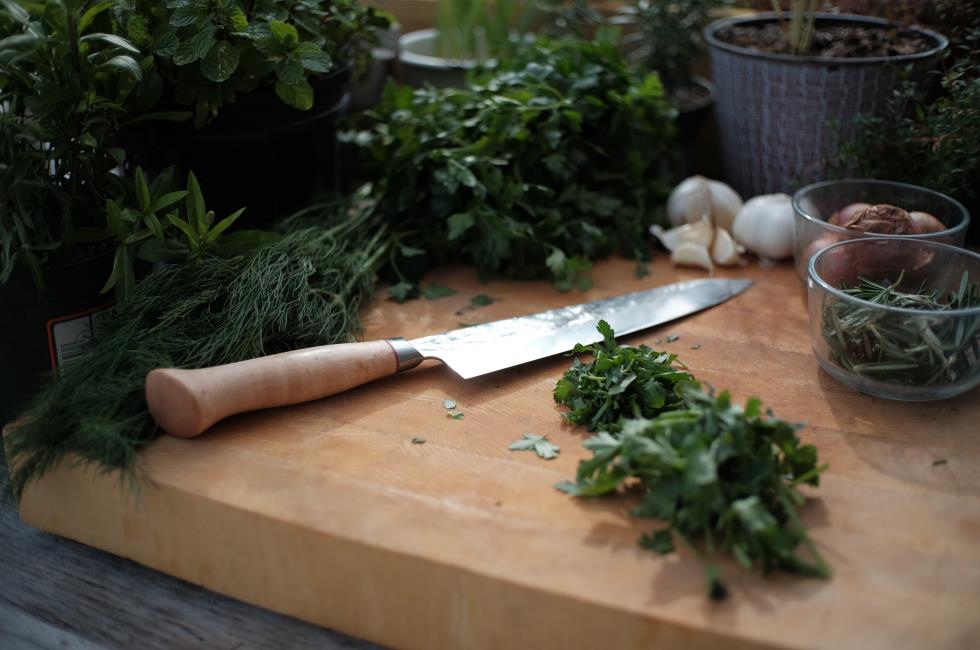
Dimensions
It may seem obvious, but it bears stating – the size of the knife handle should be suited to the customer’s hand size.
A customer with tiny hands or joint problems is not going to be able to use a heavy, overly bulbous knife handle easily and safely.
On the opposite side of the spectrum, a professional chef jointing down large pieces of animal daily will be frustrated and possibly injured by a smooth textured, lightweight handle that offers little grip.
Ideally, the customer should be offered a range of knife handle sizes so that they can choose a handle that’ll fit their hand comfortably.
This means that both fingers and palm are in contact with the handle without discomfort or wrist strain.
Aligning knife handle with functionality
An effective knife handle will give the user:
- Ease of movement
- Fluidity in the cutting stroke
- Good directional and force control
- A sense of security because their grip is firm
- Protection from food related bacteria
- Low maintenance performance
- An attractive addition to their cookware
These elements all need to be brought into conjunction with clever design and ergonomics that suit the task that the knife was created for.
A gorgeous knife is something to behold, but form MUST meet function.
For customers involved in professional food preparation a very tough and durable knife handle is best as the knife will see use (and abuse) day in and day out.
For your home cook, a more elegantly shaped and crafted handle could be appropriate because the knife is not used as heavily or as often.
For those involved in seafood or fish preparation, such as sushi or sashimi chefs, an octagonally shaped ‘wa’ handle in the Japanese style offers more sideways grip when filleting and slicing slippery fish.
The needs of the cook concerned, and the purpose of the knife involved should marry neatly with how the knife handle is contoured and designed.
Maintenance
A knife and its handle (dependent on the material) will require particular and specific levels of maintenance.
It helps the customer if you sell them a knife that suits their lifestyle and time available for product maintenance.
Cleaning
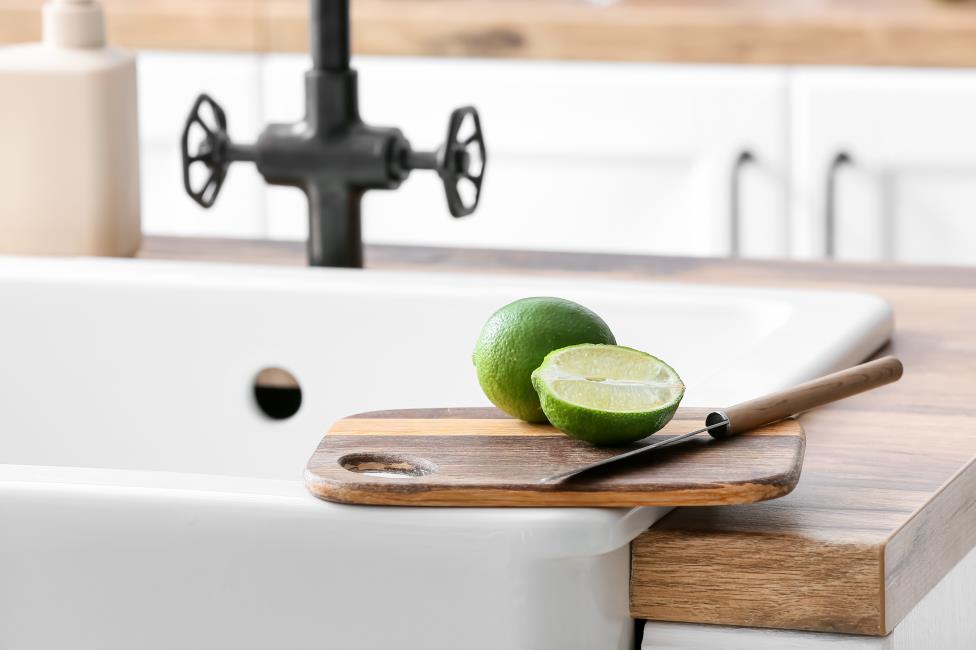
Knives, particularly wood handled knives, shouldn’t be washed in the dishwasher, and need to be dried thoroughly after washing.
Oiling
Knives with wood or wood composite handles need to be oiled around twice a year.
For this your customer can use food grade mineral oil or Boiled Linseed oil, which is much faster drying than regular Linseed oil.
Carbon fiber knife handles won’t require oiling, they’re easy that way.
For G10 knives, a soft toothbrush and hot soapy water are great for cleaning, and for surface oiling a product called Ballistol rubbed into the completely dry G10 surface will restore shine and color.
What kind of knife handles should you include in your range?

As the more ‘visual’ part of the knife, the choice of knife handle is influenced by the customer’s taste, culture, and preconceived ideas about what a knife should look like.
Also, people will have preferences for easy clean, low maintenance synthetics like G10 whereas others will hold fast and true to the stunning natural handle materials such as wood.
For this reason, it’s important to get your customer’s input and align them with the right product for them.
A good range of knife handle materials (both natural and synthetic) is always prudent as this allows you to have something readily on hand for every buyer.
Tried and tested wood knife handles are a market winner and have stood the test of time with buyers, so carry a wide range of both natural wood and ‘wood look’ composite products – these won’t let you down!
Stabilized wood in particular offers great knife handle performance and is so customizable that no customer need be disappointed in achieving the aesthetic that they desire.
In conclusion
Knife handles offer such a broad field for customization and personal taste that it’s no wonder that many people regard the handle as the most interesting part of the knife!
With the appropriate base material and skilled ergonomics that fit the hand, knife handles have come a long way in recent decades.
At LeeKnives we pride ourselves on offering the best available thinking and design when crafting our knives, and that patience and research is reflected in our product range.
Need a quote for a sales venture? We’ll shoot the numbers with you at our quote portal.


